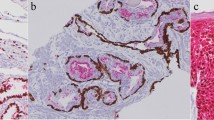Abstract
An accurate diagnosis of metastases to the ovary is essential for adequate patient management. The aim of this retrospective study was to characterize clinicopathological features of metastatic malignancies that presented as an ovarian mass and compare them with their corresponding primary tumors. We reviewed clinical files and histological material of 120 patients with metastases to the ovary, diagnosed in our center between 2000 and 2014. Metastases were diagnosed before (18 %), synchronously (33 %), or after (49 %) the primary tumor was identified; 25 % were single, 40 % were unilateral; 47 % were ≥13 cm. Most originated from the gastrointestinal tract (73 %), followed by breast (13 %), and female reproductive organs (10 %). Gross features varied with primary tumor site. Metastases from gastrointestinal malignancies were significantly larger and frequently showed necrosis. Metastases to the appendix were cystic (94 %), and almost all metastases to the stomach (96 %) and breast (87 %) were solid. The predominant histological pattern was discordant in 44 % cases, mostly due to cystic changes in ovarian metastases which were observed across several histological types. Other metastases showed a predominant histological pattern which was present only focally in the primary tumor. Metastases showed significantly more edema, necrosis, and hemorrhage, but less lymphovascular invasion and inflammatory infiltrate than the corresponding primary tumors. Metastases to the ovary present highly variable clinicopathological features which frequently differ from those of the corresponding primary tumor. A metastasis should always be considered in the differential diagnosis of an ovarian mass. All clinical, imaging, macroscopic, and histological aspects must be taken into account to establish a correct diagnosis which is essential for adequate treatment.




Similar content being viewed by others
References
Acs G (2002) Intraoperative consultation in gynecologic pathology. Semin Diagn Pathol 19:237–254
Akhan SE, Kilic G, Salihoglu Y, Bengisu E, Berkman S (2001) Nongenital metastatic cancers of the ovary: a clinical analysis. Eur J Gynaecol Oncol 22:379–383
Antila R, Jalkanen J, Heikinheimo O (2006) Comparison of secondary and primary ovarian malignancies reveals differences in their pre- and perioperative characteristics. Gynecol Oncol 101:97–101. doi:10.1016/j.ygyno.2005.09.046
Ayhan A, Guvenal T, Salman MC, Ozyuncu O, Sakinci M, Basaran M (2005) The role of cytoreductive surgery in nongenital cancers metastatic to the ovaries. Gynecol Oncol 98:235–241. doi:10.1016/j.ygyno.2005.05.028
Baker P, Oliva E (2008) A practical approach to intraoperative consultation in gynecological pathology. International journal of gynecological pathology : official journal of the International Society of Gynecological Pathologists 27:353–365. doi:10.1097/PGP.0b013e31815c24fe
Blagden SP (2015) Harnessing pandemonium: the clinical implications of tumor heterogeneity in ovarian cancer. Frontiers in oncology 5:149. doi:10.3389/fonc.2015.00149
Brown J, Frumovitz M (2014) Mucinous tumors of the ovary: current thoughts on diagnosis and management. Curr Oncol Rep 16:389. doi:10.1007/s11912-014-0389-x
Bruchim I, Ben-Harim Z, Piura E, Tepper R, Fishman A (2013) Preoperative clinical and radiological features of metastatic ovarian tumors. Arch Gynecol Obstet 288:615–619. doi:10.1007/s00404-013-2776-1
Bruls J, Simons M, Overbeek LI, Bulten J, Massuger LF, Nagtegaal ID (2015) A national population-based study provides insight in the origin of malignancies metastatic to the ovary. Virchows Archiv: an International Journal of Pathology 467:79–86. doi:10.1007/s00428-015-1771-2
Chen EY, Lee KR, Nucci MR (2011) Intraoperative evaluation of ovarian tumors. In: Crum CP, Nucci MR, Lee KR (eds) Diagnostic gynecologic and obstetric pathology, Second edn. Saunders-Elsevier, Philadelphia, pp. 800–817
Clement PB, Young RH (2013) Metastatic tumors of the ovary (including Pseudomyxoma Peritonei, Hematolymphoid neoplasms, and tumors with functioning stroma) atlas of gynecologic surgical pathology. Saunders-Elsevier, Philadelphia, pp. 483–512
de Waal YR, Thomas CM, Oei AL, Sweep FC, Massuger LF (2009) Secondary ovarian malignancies: frequency, origin, and characteristics. International journal of gynecological cancer: official journal of the International Gynecological Cancer Society 19:1160–1165. doi:10.1111/IGC.0b013e3181b33cce
DeCostanzo DC, Elias JM, Chumas JC (1997) Necrosis in 84 ovarian carcinomas: a morphologic study of primary versus metastatic colonic carcinoma with a selective immunohistochemical analysis of cytokeratin subtypes and carcinoembryonic antigen. International journal of gynecological pathology : official journal of the International Society of Gynecological Pathologists 16:245–249
Hanahan D, Weinberg RA (2011) Hallmarks of cancer: the next generation. Cell 144:646–674. doi:10.1016/j.cell.2011.02.013
Hart WR (2005) Diagnostic challenge of secondary (metastatic) ovarian tumors simulating primary endometrioid and mucinous neoplasms. Pathol Int 55:231–243. doi:10.1111/j.1440-1827.2005.01819.x
Hirsch MS (2011) Metastatic tumors of the ovary. In: Crum CP, Lee KR, Nucci MR (eds) Diagnostic gynecologic and obstetric pathology. Saunders-Elsevier, Philadelphia, pp. 972–988
Howlader N, Noone AM, Krapcho M, Garshell J, Miller D, Altekruse SF, Kosary CL, Yu M, Ruhl J, Tatalovich Z, Mariotto A, Lewis DR, Chen HS, Feuer EJ, Cronin KA (based on November 2014 SEER data submission, posted to the SEER web site, April 2015) Surveillance, Epidemiology, and End Results Program Cancer Statistics Review, 1975–2012. National Cancer Institute, Bethesda
Judson K, McCormick C, Vang R, Yemelyanova AV, Wu LS, Bristow RE, Ronnett BM (2008) Women with undiagnosed colorectal adenocarcinomas presenting with ovarian metastases: clinicopathologic features and comparison with women having known colorectal adenocarcinomas and ovarian involvement. International journal of gynecological pathology: official journal of the International Society of Gynecological Pathologists 27:182–190. doi:10.1097/PGP.0b013e31815b9752
Khunamornpong S, Suprasert P, Chiangmai WN, Siriaunkgul S (2006) Metastatic tumors to the ovaries: a study of 170 cases in northern. Thailand International journal of gynecological cancer: official journal of the International Gynecological Cancer Society 16(Suppl 1):132–138. doi:10.1111/j.1525-1438.2006.00302.x
Khunamornpong S, Suprasert P, Pojchamarnwiputh S, Na Chiangmai W, Settakorn J, Siriaunkgul S (2006) Rimary and metastatic mucinous adenocarcinomas of the ovary: evaluation of the diagnostic approach using tumor size and laterality. Gynecol Oncol 101:152–157. doi:10.1016/j.ygyno.2005.10.008
Kondi-Pafiti A, Kairi-Vasilatou E, Iavazzo C, Dastamani C, Bakalianou K, Liapis A, Hassiakos D, Fotiou S (2011) Metastatic neoplasms of the ovaries: a clinicopathological study of 97 cases. Arch Gynecol Obstet 284:1283–1288. doi:10.1007/s00404-011-1847-4
Kurman JR, Carcangiu ML, Herrington CS, Young RH (2014) World Health Organization classification of tumours of female reproductive organs. International Agency for Research on Cancer, Lyon
Lee KR, Young RH (2003) The distinction between primary and metastatic mucinous carcinomas of the ovary: gross and histologic findings in 50 cases. Am J Surg Pathol 27:281–292
Leen SL, Singh N (2012) Pathology of primary and metastatic mucinous ovarian neoplasms. J Clin Pathol 65:591–595. doi:10.1136/jclinpath-2011-200162
Lerwill MF, Young RH (2006) Ovarian metastases of intestinal-type gastric carcinoma: a clinicopathologic study of 4 cases with contrasting features to those of the Krukenberg tumor. Am J Surg Pathol 30:1382–1388. doi:10.1097/01.pas.0000213256.75316.4a
Lewis MR, Euscher ED, Deavers MT, Silva EG, Malpica A (2007) Metastatic colorectal adenocarcinoma involving the ovary with elevated serum CA125: a potential diagnostic pitfall. Gynecol Oncol 105:395–398. doi:10.1016/j.ygyno.2006.12.035
McCluggage WG (2008) My approach to and thoughts on the typing of ovarian carcinomas. J Clin Pathol 61:152–163. doi:10.1136/jcp.2007.049478
Moore RG, Chung M, Granai CO, Gajewski W, Steinhoff MM (2004) Incidence of metastasis to the ovaries from nongenital tract primary tumors. Gynecol Oncol 93:87–91. doi:10.1016/j.ygyno.2003.12.039
Rouzbahman M, Chetty R (2015) Republished: mucinous tumours of appendix and ovary: an overview and evaluation of current practice. Postgrad Med J 91:41–45. doi:10.1136/postgradmedj-2013-202023rep
Scully R, Young R, Clement P (1998) Tumors of the ovary, maldeveloped gonads, fallopian tube, and broad ligament. Atlas of Tumor Pathology Armed Forces Institute of Pathology, Washington DC
Seidman JD, Kurman RJ, Ronnett BM (2003) Primary and metastatic mucinous adenocarcinomas in the ovaries: incidence in routine practice with a new approach to improve intraoperative diagnosis. Am J Surg Pathol 27:985–993
Soslow RA (2011) Mucinous ovarian carcinoma: slippery business. Cancer 117:451–453. doi:10.1002/cncr.25453
Stewart CJ, Ardakani NM, Doherty DA, Young RH (2014) An evaluation of the morphologic features of low-grade mucinous neoplasms of the appendix metastatic in the ovary, and comparison with primary ovarian mucinous tumors. International journal of gynecological pathology: official journal of the International Society of Gynecological Pathologists 33:1–10. doi:10.1097/PGP.0b013e318284e070
Storms AA, Sukumvanich P, Monaco SE, Beriwal S, Krivak TC, Olawaiye AB, Kanbour-Shakir A (2012) Mucinous tumors of the ovary: diagnostic challenges at frozen section and clinical implications. Gynecol Oncol 125:75–79. doi:10.1016/j.ygyno.2011.12.424
Yada-Hashimoto N, Yamamoto T, Kamiura S, Seino H, Ohira H, Sawai K, Kimura T, Saji F (2003) Metastatic ovarian tumors: a review of 64 cases. Gynecol Oncol 89:314–317
Yemelyanova AV, Vang R, Judson K, Wu LS, Ronnett BM (2008) Distinction of primary and metastatic mucinous tumors involving the ovary: analysis of size and laterality data by primary site with reevaluation of an algorithm for tumor classification. Am J Surg Pathol 32:128–138. doi:10.1097/PAS.0b013e3180690d2d
Young RH (2007) From Krukenberg to today: the ever present problems posed by metastatic tumors in the ovary. Part II. Adv Anat Pathol 14:149–177. doi:10.1097/PAP.0b013e3180504abf
Zaino RJ, Brady MF, Lele SM, Michael H, Greer B, Bookman MA (2011) Advanced stage mucinous adenocarcinoma of the ovary is both rare and highly lethal: a gynecologic oncology group study. Cancer 117:554–562. doi:10.1002/cncr.25460
Author information
Authors and Affiliations
Corresponding author
Ethics declarations
Funding
This study received no funding.
Conflict of interest
The authors declare that they have no conflict of interest.
Electronic supplementary material
Supplementary Table-Online Resource 1
(DOCX 19 kb)
Supplementary Table-Online Resource 2
(DOCX 18 kb)
Supplementary Table-Online Resource 3
(DOCX 15 kb)
Supplementary Table-Online Resource 4
(DOCX 15 kb)
Supplementary Table-Online Resource 5
(DOCX 22 kb)
Supplementary Figure-Online Resource 6
(Cystic changes in ovarian metastases (right) compared to primary tumors (left): A, B - intestinal adenocarcinoma of the small bowel showing a glandular cribriform pattern in the primary tumor that becomes predominantly cystic in the metastasis; C, D - gastric tubular adenocarcinoma with solid and cribriform pattern in the primary tumor and a well-differentiated tubulo-cystic pattern in the metastasis; E, F - low-grade appendiceal mucinous neoplasm that showed a villous and undulating epithelia lining the appendix lumen and the corresponding ovarian metastasis with a multicystic pattern, frequently lined by a simple cuboidal or columnar epithelia. Scale bar = 200 μm. JPEG 244 kb)
Rights and permissions
About this article
Cite this article
Lobo, J., Machado, B., Vieira, R. et al. The challenge of diagnosing a malignancy metastatic to the ovary: clinicopathological characteristics vary and morphology can be different from that of the corresponding primary tumor. Virchows Arch 470, 69–80 (2017). https://doi.org/10.1007/s00428-016-2029-3
Received:
Revised:
Accepted:
Published:
Issue Date:
DOI: https://doi.org/10.1007/s00428-016-2029-3




